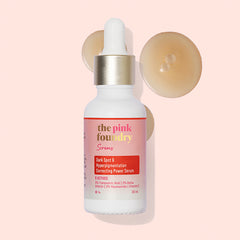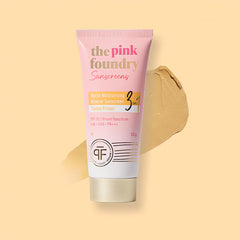Understanding Active Ingredients in Skincare: A Guide to Actives
- What Are Active Ingredients in Skincare?
- List of Popular Active Ingredients in Skincare
- How Do Active Ingredients Benefit Skin?
- How to Choose the Right Active Ingredients for Your Skin
- Active Ingredients for Common Skin Concerns
- Incorporating Active Ingredients into Your Skincare Routine
- Potential Risks and How to Use Actives Safely
- Conclusion
- FAQs
Taking care of one's skin is important, but so many products and ingredients in the market can get confusing. Active skincare ingredients refer to specific scientifically proven ingredients for targeted skincare benefits.
Understanding these active ingredients and their actions is key to building an effective skincare routine tailored to the skin's unique needs. This guide will explain active ingredients, provide an overview of the most popular actives, discuss how they benefit skin, and offer tips for safely incorporating active ingredients into one's skincare routine.
What Are Active Ingredients in Skincare?
So what are actives in skincare? Active ingredients or “actives” refer to ingredients in skincare products that directly have biological action on the skin. They interact with the skin on a cellular level to provide targeted benefits like visible improvement of skin concerns. Some common categories of active ingredients include the following:
- Antioxidants: Antioxidants are beneficial for neutralising free radicals in the skin and environmental damage. Examples include vitamin C and green tea extract.
- Acids: Alpha-hydroxy acids (AHAs) and Beta-Hydroxy Acids (BHAs) can exfoliate the skin and unclog pores. Examples are AHAs like glycolic acid and BHAs like salicylic acid.
- Retinoids: Retinoids are derivatives of vitamin A that increase collagen production and cell turnover. Examples include retinol and tretinoin.
- Peptides: Amino acid chains that provide anti-ageing effects. Popular peptides include copper peptides and Argireline.
List of Popular Active Ingredients in Skincare
This section offers a list of active ingredients in skincare. Here is an overview of some of the most widely used and researched actives in skincare:
- Retinol: Retinol is arguably the gold-standard wrinkle-reducing ingredient. As a vitamin A derivative, it boosts collagen, evens skin tone, reduces fine lines, and unclogs the pores. One can start with lower percentages, around 0.2%, before reaching higher strengths.
- Vitamin C: A potent antioxidant, vitamin C shields the skin from free radicals, increases brightness and radiance, and may help stimulate collagen. One should look for stable formulas containing L-ascorbic acid.
- Hyaluronic Acid: This moisture magnet plumps skin, smooths fine lines, and forms a hydrating barrier. For multi-depth hydration, one can use lightweight serums with multiple molecular weights of HA.
- Niacinamide: Also known as vitamin B3, niacinamide is a multitasking ingredient that strengthens the skin barrier, reduces inflammation and blotchiness, balances sebum activity, and improves texture.
- AHAs and BHAs: Alpha hydroxy acids (AHAs), like glycolic and lactic acids, deeply exfoliate, even pigmentation, and boost radiance. Beta hydroxy acids (BHAs) like salicylic acid penetrate oil and debris in pores to prevent breakouts without stripping skin. Start using AHA/BHA toners or serums once or twice a week before slowly increasing frequency based on skin tolerance.
- Peptides: Chains of amino acids that provide wrinkle-related and skin-restoring benefits. Peptides like copper peptides and Argireline may stimulate collagen and relax wrinkles. One should consider using peptide-based serums and moisturisers twice daily for noticeable improvement over 2-3 months.
How Do Active Ingredients Benefit Skin?
There are several key ways that active ingredients can improve skin health and appearance. Some of the notable benefits include the following:
- Smoothing Wrinkles: Ingredients like retinoids, peptides, and antioxidants like vitamin C counteract wrinkles, loss of firmness and elasticity, and spots by stimulating collagen production, cell turnover, skin repair, and more.
- Brightening and skin tone improvement: Actives like vitamin C, niacinamide, AHAs, azelaic acid, and more inhibit melanin production and pigmentation to even the skin tone, reduce dark spots, and enhance radiance.
- Hydration and moisture retention: Hydrating actives like hyaluronic acid, glycerin, ceramides, and urea draw moisture to the skin, soften dryness, and strengthen the skin's moisture barrier to help skin retain hydration.
- Acne and blemish reduction: BHAs like salicylic acid, benzoyl peroxide, and sulfur penetrate pores, remove excess oil and dead skin cells, kill p.acnes bacteria, and prevent future breakouts.
How to Choose the Right Active Ingredients for Your Skin
With so many active ingredients available, knowing which ones to choose can be tricky. Here are some tips one can consider:
- Determine your skin type and concerns (oily, dry, acne-prone). Focus on activities that target your specific skin needs.
- Focus on specific active ingredients targeting skin concerns. Retinoids and peptides are beneficial for skin drying and wrinkles. BHAs are beneficial for acne and clogged pores. Vitamin C and niacinamide can help clear dark spots and dullness. Skincare products containing hyaluronic acid are beneficial for dryness-related issues.
- Start with lower percentages and build up frequency slowly to gauge skin tolerance. Discontinue use if irritation occurs.
- Layer serums with complementary actives (e.g. niacinamide + retinol), but avoid using certain acids (AHAs and BHAs) together to prevent over-exfoliation.
Active Ingredients for Common Skin Concerns
Here is an overview of some top skin concerns and the active ingredients that can provide solutions:
|
Skincare Conditions |
Possible Solutions (Skincare Ingredients) |
|
Acne |
BHAs, benzoyl peroxide, azelaic acid, niacinamide, and sulfur |
|
Ageing |
Retinoids, peptides, antioxidants (vitamin C), and AHAs |
|
Hyperpigmentation |
Vitamin C, hydroquinone (prescription), niacinamide, AHAs, and azelaic acid |
|
Dryness |
Hyaluronic acid, ceramides, glycerin, and urea |
Incorporating Active Ingredients into Your Skincare Routine
When adding skincare products containing active ingredients into one's routine, it is crucial to do so slowly and carefully to allow the skin to make adjustments and prevent irritation:
- Patch test first by applying a small amount on your inner arm for 24-48 hours to check for allergic reactions before using it on the face.
- Start using active ingredients 2-3 times a week, then gradually increase to daily use if tolerated.
- Layer lighter textures first, like toners or serums, before using richer creams and moisturisers.
- Always wear SPF in the AM (morning) when using active ingredients that increase sun sensitivity, like AHAs and retinoids.
Potential Risks and How to Use Actives Safely
While active ingredients can provide incredible skin benefits, they also come with risks. Possible risks include irritation, dryness, and sun sensitivity when overused. Some tips for safe use include the following:
- Always patch test first and introduce new active ingredients slowly into the routine.
- Use only 1-2 stronger actives per routine. Consider starting with actives like retinoids or leave-on acids.
- Avoid excessive exfoliation from combining multiple acids at once.
- Stay diligent with higher SPF sunscreens to protect the skin from increased photosensitivity.
- Reduce application if irritation, peeling, redness or dry skin occurs and stop use if it persists.
- Drink plenty of water and use gentle moisturisers to counteract the drying effects.
Conclusion
Understanding what active ingredients target which skin concerns is key to developing an effective, customised skincare routine. Active ingredients provide clinical solutions to common skin issues, but introducing them properly into the skincare regimen is vital for reaping the benefits safely.
Consult a dermatologist if you are concerned about using actives for your skin type or condition. Consistent use of the right activities tailored to one's skin goals can reveal healthy, radiant skin over time.
FAQs
Q1: What are the most effective active ingredients for anti-ageing?
A1: The gold standard anti-ageing active ingredients are retinoids, vitamin C, peptides, AHAs, growth factors, antioxidants like CoQ10 and EGCG, and niacinamide. Combining these ingredients can help one attain comprehensive anti-ageing action on multiple facets of skin ageing.
Q2: Can I use Vitamin C and Retinol together?
A2: Vitamin C and retinol can be used together by layering them properly. People prefer to use them alternatively in the morning and the evening. Since they are both active ingredients that can irritate, it is crucial to introduce them slowly, one at a time, before using them together. One should avoid applying them at the same time.
Q3: How do I know which active ingredients suit my skin type?
A3: If one has oily, acne-prone skin, it is better to look for BHAs like salicylic acid and oil-controlling ingredients like niacinamide and sulfur. For people with dry skin, focusing on hydration with skincare products with ingredients like hyaluronic acid, ceramides, peptides, and glycerin can be better. People with relatively mature skin will benefit from collagen stimulators like retinoids, peptides, and antioxidants.
Q4: What is the best way to start using active ingredients in skincare?
A4: It can be better to patch test the active ingredients first and then slowly introduce them 2-3 times a week at low percentages into the morning or night skincare routine before beginning daily use. It is important to monitor the skin's tolerance and reduce application if irritation occurs.











